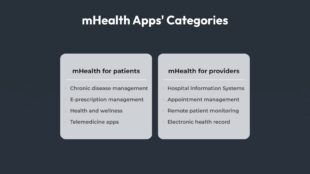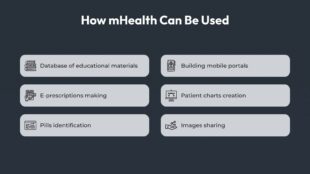mHealth is growing in popularity for delivering healthcare services outside of traditional settings. By using healthcare mobile solutions, the individuals can improve access to care even with geographic or financial constraints.
This article is prepared to examine the advantages of mHealth technology and explore reasons to implement it into your internal processes.
Why mHealth Needs to Be Adopted
The future of medical consultations is rapidly shifting from the traditional face-to-face doctor’s visit to online or mobile health (aka mHealth) options. mHealth technology is paving the way for a new era of virtual healthcare, offering more convenient and accessible care for patients.
Thus, healthcare providers can use smartphones and other mobile devices to remotely monitor patients’ conditions, track their progress in real-time, and create personalized care plans based on individual needs. This technology is now being used in various settings, including clinical and non-clinical environments such as schools, home care, and workplaces.

The mHealth apps are split into the above categories
A Closer Look at the Cost-Saving Benefits of Mobile Health Apps
Mobile health apps offer various benefits, including the management of different chronic and dangerous illnesses and the provision of remote consultation and diagnosis services, or offering the medical educational materials (like LMS systems for healthcare). Moreover, these apps allow patients to access healthcare services easily, regardless of where they are or the time, while also enabling medical professionals to monitor and manage patient data in real-time.
We have compiled the most common benefits that the mHealth solutions may bring to your business. We invite you to explore them and make your decision.
- Mobile health apps increase accessibility to care, which is especially helpful for patients who face geographical or financial constraints.
- Moreover, mHealth applications enable enhanced communication between healthcare providers and patients, leading to more accurate diagnoses and treatments tailored to an individual’s needs.
- They are also convenient, allowing patients to access their medical information, schedule appointments, and monitor their progress over time. This reduces the need for unnecessary doctor visits, lowering healthcare costs and reducing the paperwork and administrative costs associated with traditional care models.
- Finally, mHealth applications can improve patient outcomes by managing chronic conditions and detecting early warning signs. This is achieved through increased access to care, improved communication between healthcare providers, physicians and patients, and convenient progress tracking.
How Mobile Technology is Enhancing the Patient-Doctor Relationship
The utilization of mobile technology in the healthcare industry is experiencing significant growth. Healthcare providers and organizations are recognizing the significance of efficient and reliable healthcare solutions, resulting in an increased demand for mHealth apps with innovative uses.
Telemedicine is a practical application that makes use of chatbot software. The software possesses AI and natural language processing capabilities that assist in guiding patients through a diagnostic interview. The technology also allows providers to increase their patient capacity and provide high-quality care from a distance.
Moreover, the digital health records securely store patient information, which helps to reduce paperwork. The caregivers also have the option to utilize apps that can assist them in tracking medications, setting alarms, and receiving reminders. This way, mHealth apps provide convenience and contribute to improved health outcomes.

mHealth App Development Flow: From Idea to Release
The mHealth app development can be broken down into several distinct steps. Look at our prepared overview to make the flow clear for you, which will help you plan your time before the mHealth development starts.
Conceptualization. The initial stage of the development process involves brainstorming ideas for a mHealth app. It means you should conduct brainstorming, researching, and deciding on the functionality that will be included in the app.
Design stage. UI/UX designers create wireframes or mockups that determine the visual and functional aspects of the app, such as colors, fonts, images, and navigation elements. These elements will be utilized throughout the entire design process.
Development and testing. In this phase, your EHR software development company creates a working version of the solution based on the design created in the previous step. This includes coding for all of the app’s features and functionality and debugging to ensure everything works properly.
Before releasing the app into production, it must undergo rigorous testing to ensure it meets quality standards and performs as expected on various devices and operating systems.
Release. Once all tests have been passed with flying colors, the application can finally be released to users.
Conclusion
Mobile health technology offers convenience, accessibility, and cost savings for healthcare providers and patients alike. mHealth tech can be used to diagnose and monitor conditions, provide remote patient monitoring, deliver personalized care plans, manage chronic illnesses, collect data for research purposes, and facilitate communication between doctor and patient. As mHealth technology continues to evolve, so too will the opportunities for healthcare providers and patients.
Deciding to start mHealth software development, you should care about finding a healthcare software development vendor that will help you with solving all the problems and intricacies the healthcare solution creation can contain. The vendor’s specialists will carefully guide you through the building process, delivering you a seamless app that will be profitable and helpful for your business.

